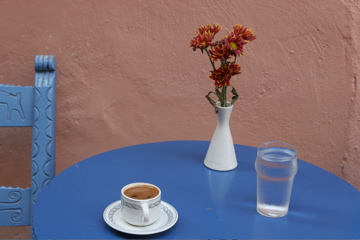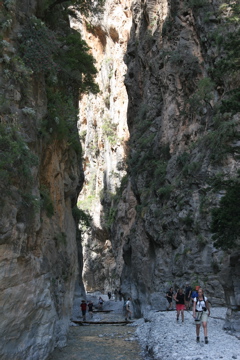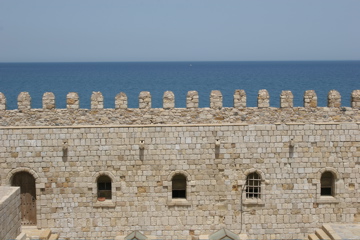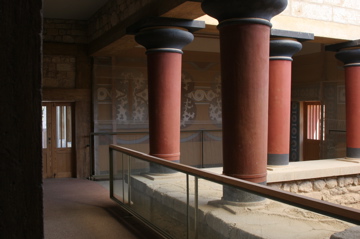Crete
May 1-8, 2007
All In One
Crete seems to have a bit of everything: Ancient Minoan ruins, cute towns, gorgeous nature, a real city, beautiful beaches. No wonder it also has lots of tourists, and when I addressed locals in English, the answer was more likely in German than in Greek. Occasionally it was a bit too much, but most of the time it was welcoming in a pleasant way.
Every Ruin a Restaurant
 The old town of Hania is cute, sometimes too cute. Most of the Venetian houses
have been converted to hotels and souvenir stores, and every ruin in between
into a restaurant. It’s pleasant to hang out, have a
coffee, walk around the harbor, have
another coffee, go to the little art exhibition in the former mosque, eat a
tasty meal, and forget about the world outside for a day or two.
The old town of Hania is cute, sometimes too cute. Most of the Venetian houses
have been converted to hotels and souvenir stores, and every ruin in between
into a restaurant. It’s pleasant to hang out, have a
coffee, walk around the harbor, have
another coffee, go to the little art exhibition in the former mosque, eat a
tasty meal, and forget about the world outside for a day or two.
From Yosemite to the Sea
 No, Samaria Gorge is not Yosemite. But the views and vegetation at the Xyloskalo
entrance are somewhat reminiscent of Yosemite – a deep valley surrounded by
steep walls, and pine trees all around. It would take a long time to
hike from Yosemite to the sea though – at Samaria Gorge, it’s just a 16km hike,
easily done in a day. On the way, there are a variety of flowers, a little
church, an abandoned village, and a creek that disappears and reappears, possibly
reanimated by the ugly fat black hoses that show up occasionally. Towards
the end: The “Iron Gates”, where the gorge narrows to 3 meters and the rocks
soar on both sides. The village at the end, Agia Roumeli, has no road, so
the return trip is by ferry to Hora Sfakion, providing views of several additional
gorges along the coast.
No, Samaria Gorge is not Yosemite. But the views and vegetation at the Xyloskalo
entrance are somewhat reminiscent of Yosemite – a deep valley surrounded by
steep walls, and pine trees all around. It would take a long time to
hike from Yosemite to the sea though – at Samaria Gorge, it’s just a 16km hike,
easily done in a day. On the way, there are a variety of flowers, a little
church, an abandoned village, and a creek that disappears and reappears, possibly
reanimated by the ugly fat black hoses that show up occasionally. Towards
the end: The “Iron Gates”, where the gorge narrows to 3 meters and the rocks
soar on both sides. The village at the end, Agia Roumeli, has no road, so
the return trip is by ferry to Hora Sfakion, providing views of several additional
gorges along the coast.
Main Attraction Closed
 Coming from Hania, Iraklio feels like a real city. There are plenty of tourists
and hotels around, but it doesn’t feel like extracting money from tourists
is the only business. In fact, they don’t seem concerned about disappointing
their visitors by closing their main attraction, the Archaeological Museum,
with no substitute – wouldn’t it have been possible to show at least some highlights
in some other building while renovating the museum? So the Venetian fortress
becomes the main sight, which together with the other fortifications around
the old center of Iraklio withstood a Turkish siege for 22 years
before succumbing.
Coming from Hania, Iraklio feels like a real city. There are plenty of tourists
and hotels around, but it doesn’t feel like extracting money from tourists
is the only business. In fact, they don’t seem concerned about disappointing
their visitors by closing their main attraction, the Archaeological Museum,
with no substitute – wouldn’t it have been possible to show at least some highlights
in some other building while renovating the museum? So the Venetian fortress
becomes the main sight, which together with the other fortifications around
the old center of Iraklio withstood a Turkish siege for 22 years
before succumbing.
What Did Minoan Palaces Really Look Like?
 Crete was the center of the Minoan civilization, which lasted from about 3000
BC to 1100 BC and left plenty of ruins behind. I visited several of them: Knossos,
Phaestos and the nearby Agia Triada, and Zakros. Knossos makes
it easiest to imagine what a Minoan palace might have looked like, because
the archaeologist leading the excavations, the British Arthur Evans, had several
portions reconstructed the way he thought they may have been 3500 years ago.
Of course, as several signs warn, this means that what you see is Evans’s creation,
which may or may not match historic reality. In particular, the frescoes shown
at the palace are far more complete than what was actually found during the
excavations. The ruins at Phaestos and the rest, on the other hand, are just
that, ruins, and while there are maps available that give various stone pile-surrounded
rectangles names such as “Queen’s Apartment” or “Lustral Basin”, that doesn’t
really help the imagination.
Crete was the center of the Minoan civilization, which lasted from about 3000
BC to 1100 BC and left plenty of ruins behind. I visited several of them: Knossos,
Phaestos and the nearby Agia Triada, and Zakros. Knossos makes
it easiest to imagine what a Minoan palace might have looked like, because
the archaeologist leading the excavations, the British Arthur Evans, had several
portions reconstructed the way he thought they may have been 3500 years ago.
Of course, as several signs warn, this means that what you see is Evans’s creation,
which may or may not match historic reality. In particular, the frescoes shown
at the palace are far more complete than what was actually found during the
excavations. The ruins at Phaestos and the rest, on the other hand, are just
that, ruins, and while there are maps available that give various stone pile-surrounded
rectangles names such as “Queen’s Apartment” or “Lustral Basin”, that doesn’t
really help the imagination.
Cretan Ethnology
The village Vori has a Museum of Cretan Ethnology with a fascinating collection of musical instruments, clothing, tools, furniture, and other items that bring the traditions of Crete back to life. It’s a 45 minute walk from Agia Triada, and there’s a bus going back to Iraklio – quite a sight watching these huge whales navigating the narrow village streets.
Land’s End
 Zakros today is about as far away from it all as one can get on Crete, but
for the Minoans it was a major port handling trade with Egypt and the East.
Between the Minoan palace on the coast and the modern village 8km inland stretches
the Valley of the Dead, a gorge where the Minoans buried their dead in cave
tombs. The caves I checked while hiking through the valley seemed to house
only sheep, however. Further along the coast is the larger Pelekita cave –
no signs of Minoan civilization here either as far as I dared go, but some
nice stalagmites.
Zakros today is about as far away from it all as one can get on Crete, but
for the Minoans it was a major port handling trade with Egypt and the East.
Between the Minoan palace on the coast and the modern village 8km inland stretches
the Valley of the Dead, a gorge where the Minoans buried their dead in cave
tombs. The caves I checked while hiking through the valley seemed to house
only sheep, however. Further along the coast is the larger Pelekita cave –
no signs of Minoan civilization here either as far as I dared go, but some
nice stalagmites.